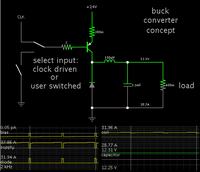T
treez
Guest
Hello,
What's the highest power possible for a buck converter with Vout = 12V
What's the highest power possible for a buck converter with Vout = 12V
Follow along with the video below to see how to install our site as a web app on your home screen.
Note: This feature may not be available in some browsers.
Hi treezWhat's the highest power possible for a buck converter with Vout = 12V

It's not necessarily so. Do you know that a recent PC processor core power supply involves current in a 100 A range at voltages of 1V and below? Just to highlight state of the art.If we work at it, we might manage to cut stray resistance as low as 0.1 ohm. Then it is possible to send over 100 A to the load, at 12V. Then the load can be about 0.1 ohm.
For reference, my motherboard can supply 110ADC to its CPU (up to 1.2V) with just four interleaved phases. So obviously they're able to keep path resistance down to the level of a few milliohms per phase, including FET and inductor resistance. There's no reason 12V at 100A would be a problem with similar technology.
does paralleling mosfets count as interleaving?
10 watts of conduction loss at 50% duty cycle is 144 amps through a 1 milliohm fet.
they make them with lower on resistance than that afaik, and seeing as you're delivering 144 amps at 12 volts, your 10 watts loss in the mosfets is negligible.
switching losses at 50Khz should be on the order of 1 watt...
It's not necessarily so. Do you know that a recent PC processor core power supply involves current in a 100 A range at voltages of 1V and below? Just to highlight state of the art.
0.01 Ohm is the load resistance. Switch and conductor resistance can be expected below milliohm.It calculates as .01 ohm. That is a remarkable achievement.
Switching losses aren't affected by the duty cycle in a first order, neither conduction losses in a synchronous switching converter.how do you figure switching losses will increase by changing the duty cycle from 10% (12v in, 1.2v out) to 50% 24v in 12v out?
assuming inductor current is sufficiently continuous (ripple is less than 30%)
ignore the increased switching losses due to the higher voltage.